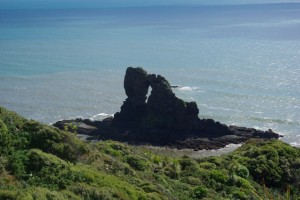Anawhata is north of White’s Beach. You can walk from Piha, or there is a long winding metal road that turns off Piha Road. Anawhata is part of the regional parkland though a great deal is actually private land.
There is a steep walk down to Anawhata beach from the road end. Once there, you need to cross the Anawhata Stream to get to the further bay, called Parera Bay. This is a spot you will see quite a lot of surfers in the right conditions. Anawhata is remote, but when I was last there, two young women turned up with pink handbags and toy dogs – not on leads, and I thought how remote is remote!
Auckland Council has strict controls on what can happen here in an effort to protect the very special values of this place.
There is the most gorgeous dune at Parera Bay, a perfect half circle which I caught in a photo as the sun went down, and I now have as my screensaver.
If you walk around the cliffs towards the south, you will get great views of Keyhole Rock.
Halfway down the walk to the beach you can continue on the road and there is Keddle House. This house was built in the 1930s by the Parkers, a well-off English couple who retired here. They gardened the steep cliffs and today you can see various garden escapes, now well acclimatised, spreading around the cliffs, especially the silver-leafed South African succulent cotyledon orbiculata. My family walked to Anawhata once and brought me back a souvenir of this plant. I potted it up and it grew luxuriantly. Fortunately I discovered it was considered a pest and destroyed it before I inadvertently spread it along the Coast.
.
Anawhata was milled as part of the Piha operation. A tramway was built from the Piha Mill to the bottom of an incline, about the location of the bottom of White’s Track. Indeed, Marawhara Walk follows the old benched route of the tramway. This was the route used by the little Dubs engine, A196. The incline ended near the Craw Homestead.
You can rent Keddle House by going online to Auckland Council Regional parks. It has solar heating and big gas bottles and is the most gorgeous spot to get a break from the city.
The shower may be cold, but its a small price to pay for such beauty and solitude.
Further back on the Anawhata Road is Craw Homestead, another of the old houses that has been restored and is available for rent. Here’s a story about the restoration https://www.piha.co.nz/craw-homestead-open-day-brings-back-memories/
Beside the house is a lovely campground that is part of the Hillary Trail. You can see it from the side of the road and book it from the Parksline in Auckland Council.
Behind the cooking shelter in the Craw Campground is a short track that leads to a great lookout all the way back to Piha.
Our bach is a long way off and directly opposite. Sometimes we train our binoculars on it and can see people far-off enjoying the view. A great spot to eat your meal if camping here.
There are many tracks off Anawhata Road either leading eastwards into the interior of the Ranges, or back down to Piha. About 4 km from the turn-off onto the Anawhata Road, there is a cluster of three tracks leading down to Piha.
Pole Line Track and Quarry Track take you downhill to the McKenzie and Forbes Tracks, then the Piha Valley Track. Centennial Track, which takes you down rocky steps to the Piha Valley Track, is one of the iconic tracks of Piha. At the top of Quarry and Centennial is the McElwain Lookout, a tower built on a high point. From here you can look over the interior of the Ranges down to Piha. It amply demonstrates why houses should be kept off ridges and paint colours should be (but aren’t controlled) as some of the rooves at Piha stand out like a sore thumb.
Further back towards town again, but on the east side of the road, is a large, beautiful paddock called Hettig Clearing. The name is a reference to Dick Hettig, one of the park rangers whose family lived here. When I was first elected to the Auckland Regional Council, the house was still there, but unused, but it has since been destroyed.
The paddock is just off the road but a bit hard to find as it is behind bush. Look for a driveway and gate just opposite the Hettig Track. The Hettig Track was where the Hettig children used to start their walk down to Piha School.









